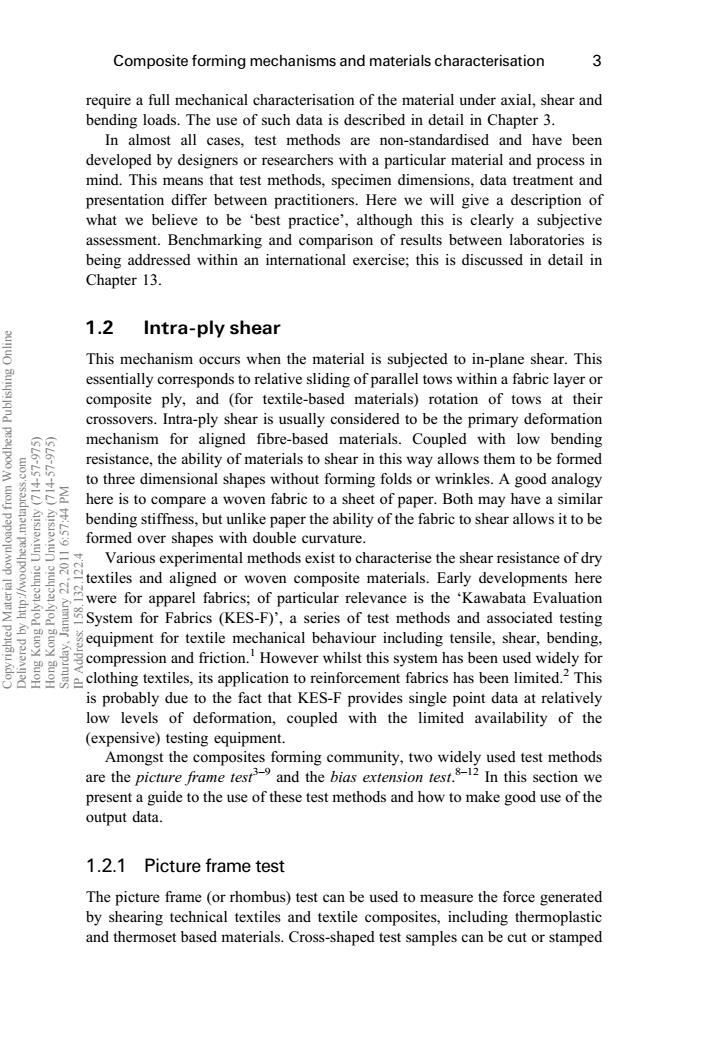正在加载图片...

Composite forming mechanisms and materials characterisation 3 require a full mechanical characterisation of the material under axial,shear and bending loads.The use of such data is described in detail in Chapter 3. In almost all cases,test methods are non-standardised and have been developed by designers or researchers with a particular material and process in mind.This means that test methods,specimen dimensions,data treatment and presentation differ between practitioners.Here we will give a description of what we believe to be 'best practice',although this is clearly a subjective assessment.Benchmarking and comparison of results between laboratories is being addressed within an international exercise;this is discussed in detail in Chapter 13. 1.2 Intra-ply shear This mechanism occurs when the material is subjected to in-plane shear.This essentially corresponds to relative sliding of parallel tows within a fabric layer or composite ply,and (for textile-based materials)rotation of tows at their crossovers.Intra-ply shear is usually considered to be the primary deformation mechanism for aligned fibre-based materials.Coupled with low bending resistance,the ability of materials to shear in this way allows them to be formed to three dimensional shapes without forming folds or wrinkles.A good analogy here is to compare a woven fabric to a sheet of paper.Both may have a similar bending stiffness,but unlike paper the ability of the fabric to shear allows it to be formed over shapes with double curvature. Various experimental methods exist to characterise the shear resistance of dry textiles and aligned or woven composite materials.Early developments here were for apparel fabrics;of particular relevance is the 'Kawabata Evaluation System for Fabrics (KES-F),a series of test methods and associated testing equipment for textile mechanical behaviour including tensile,shear,bending, compression and friction.However whilst this system has been used widely for clothing textiles,its application to reinforcement fabrics has been limited.2 This is probably due to the fact that KES-F provides single point data at relatively low levels of deformation,coupled with the limited availability of the (expensive)testing equipment. Amongst the composites forming community,two widely used test methods are the picture frame test and the bias extension test.-12 In this section we present a guide to the use of these test methods and how to make good use of the output data. 1.2.1 Picture frame test The picture frame (or rhombus)test can be used to measure the force generated by shearing technical textiles and textile composites,including thermoplastic and thermoset based materials.Cross-shaped test samples can be cut or stampedrequire a full mechanical characterisation of the material under axial, shear and bending loads. The use of such data is described in detail in Chapter 3. In almost all cases, test methods are non-standardised and have been developed by designers or researchers with a particular material and process in mind. This means that test methods, specimen dimensions, data treatment and presentation differ between practitioners. Here we will give a description of what we believe to be `best practice', although this is clearly a subjective assessment. Benchmarking and comparison of results between laboratories is being addressed within an international exercise; this is discussed in detail in Chapter 13. 1.2 Intra-ply shear This mechanism occurs when the material is subjected to in-plane shear. This essentially corresponds to relative sliding of parallel tows within a fabric layer or composite ply, and (for textile-based materials) rotation of tows at their crossovers. Intra-ply shear is usually considered to be the primary deformation mechanism for aligned fibre-based materials. Coupled with low bending resistance, the ability of materials to shear in this way allows them to be formed to three dimensional shapes without forming folds or wrinkles. A good analogy here is to compare a woven fabric to a sheet of paper. Both may have a similar bending stiffness, but unlike paper the ability of the fabric to shear allows it to be formed over shapes with double curvature. Various experimental methods exist to characterise the shear resistance of dry textiles and aligned or woven composite materials. Early developments here were for apparel fabrics; of particular relevance is the `Kawabata Evaluation System for Fabrics (KES-F)', a series of test methods and associated testing equipment for textile mechanical behaviour including tensile, shear, bending, compression and friction.1 However whilst this system has been used widely for clothing textiles, its application to reinforcement fabrics has been limited.2 This is probably due to the fact that KES-F provides single point data at relatively low levels of deformation, coupled with the limited availability of the (expensive) testing equipment. Amongst the composites forming community, two widely used test methods are the picture frame test3±9 and the bias extension test. 8±12 In this section we present a guide to the use of these test methods and how to make good use of the output data. 1.2.1 Picture frame test The picture frame (or rhombus) test can be used to measure the force generated by shearing technical textiles and textile composites, including thermoplastic and thermoset based materials. Cross-shaped test samples can be cut or stamped Composite forming mechanisms and materials characterisation 3 Copyrighted Material downloaded from Woodhead Publishing Online Delivered by http://woodhead.metapress.com Hong Kong Polytechnic University (714-57-975) Hong Kong Polytechnic University (714-57-975) Saturday, January 22, 2011 6:57:44 PM IP Address: 158.132.122.4